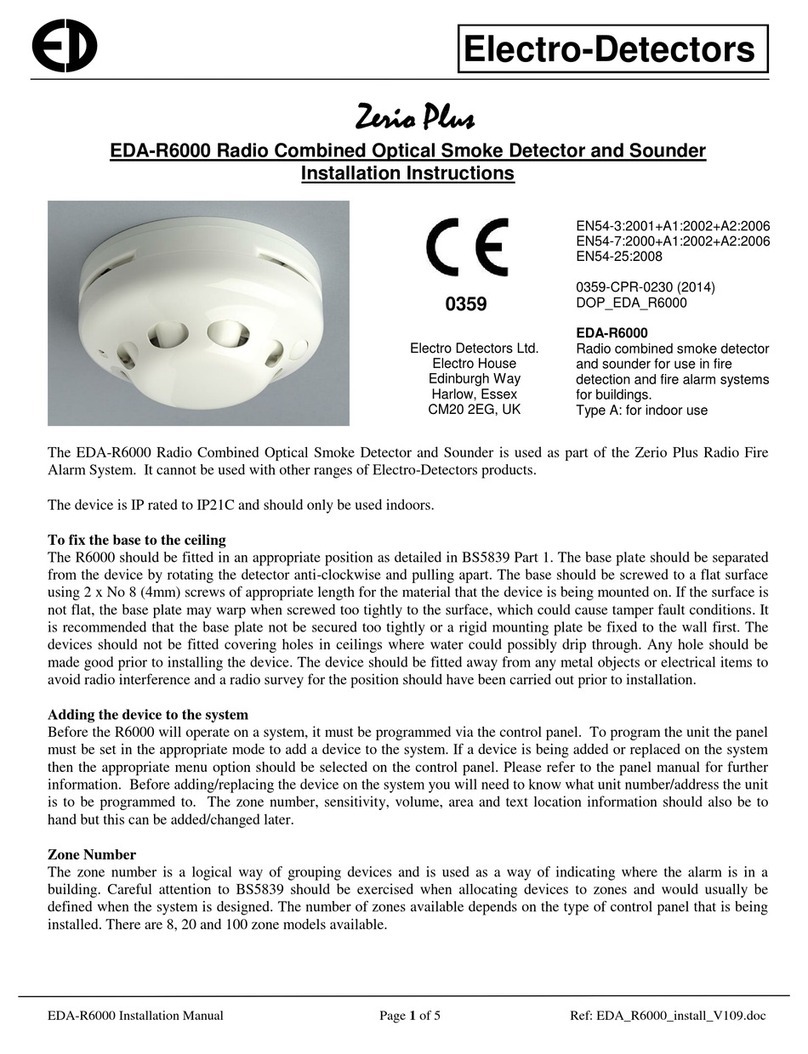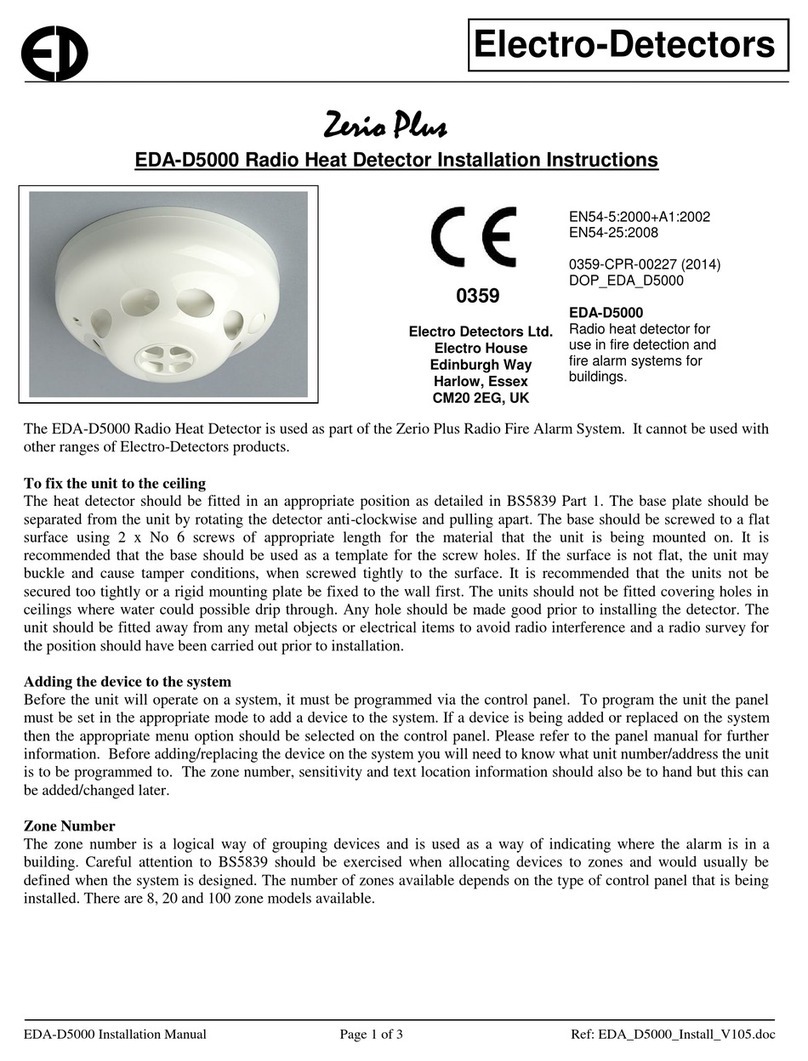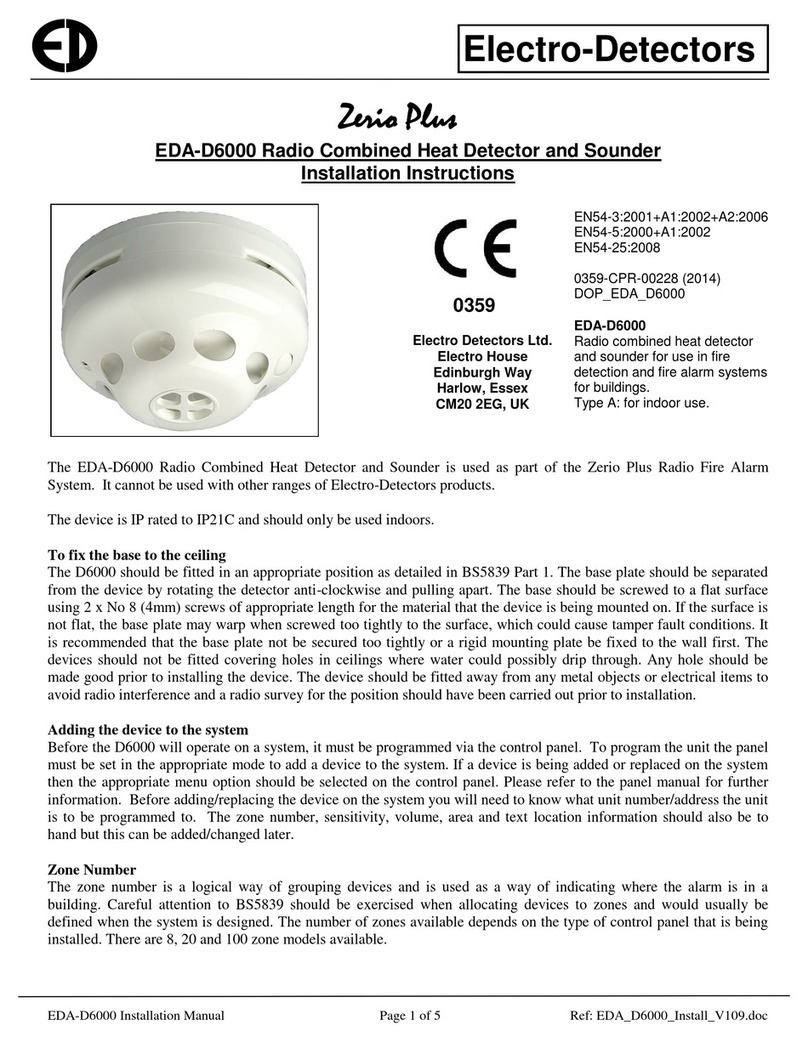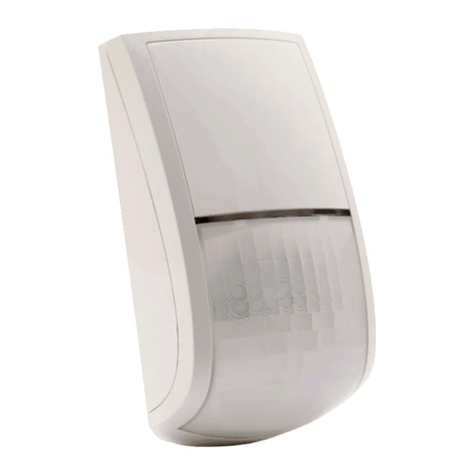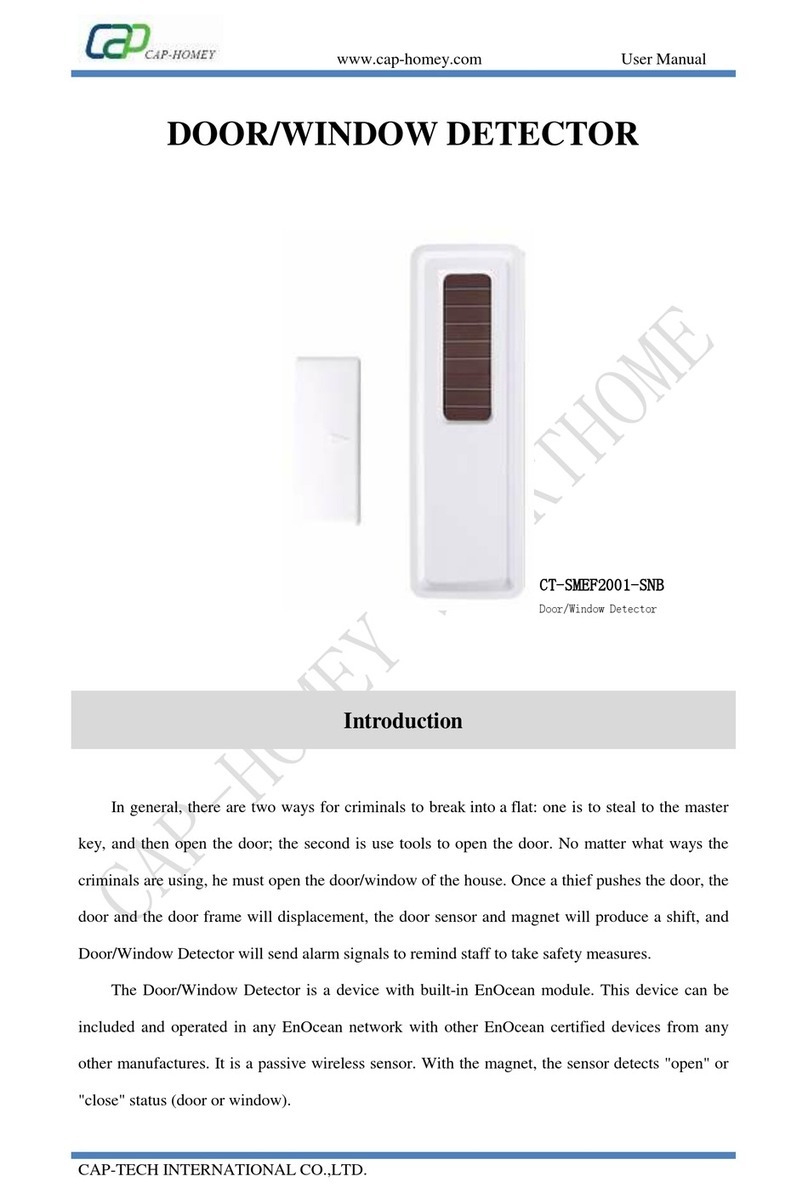Electro Detectors Zerio Plus EDA-D6000 User manual

EDA-D6000 Installation Manual Page 1 of 6 Ref: EDA_D6000_Install_V107.doc
Electro-Detectors
Zerio Plus
EDA-D6000 Radio Combined Heat Detector and Sounder
Installation Instructions
The EDA-D6000 Radio Combined Heat Detector and Sounder is used as part of the Zerio Plus Radio Fire Alarm
System. It cannot be used with other ranges of Electro-Detectors products.
The unit is rated to IP21C and should only be used for indoor use.
To fix the base to the ceiling
The heat detector should be fitted in an appropriate position as detailed in BS5839 Part 1. The base plate should be
separated from the unit by rotating the detector anti-clockwise and pulling apart. The base should be screwed to a flat
surface using 2 x No 6 screws of appropriate length for the material that the unit is being mounted on. It is
recommended that the base should be used as a template for the screw holes. If the surface is not flat, the unit may
buckle and cause tamper conditions, when screwed tightly to the surface. It is recommended that the units not be
secured too tightly or a rigid mounting plate be fixed to the wall first. The units should not be fitted covering holes in
ceilings where water could possibly drip through. Any hole should be made good prior to installing the detector. The
unit should be fitted away from any metal objects or electrical items to avoid radio interference and a radio survey for
the position should have been carried out prior to installation.
Adding the device to the system
Before the unit will operate on a system, it must be programmed via the control panel. To program the unit the panel
must be set in the appropriate mode to add a device to the system. If a device is being added or replaced on the system
then the appropriate menu option should be selected on the control panel. Please refer to the panel manual for further
information. Before adding/replacing the device on the system you will need to know what unit number/address the unit
is to be programmed to. The zone number, sensitivity, volume, area and text location information should also be to
hand but this can be added/changed later. Some of this information is left at default.
0359
Electro Detectors Ltd.
Electro House
Edinburgh Way
Harlow, Essex
CM20 2EG, UK
EN54-3:2001+A1:2002+A2:2006
EN54-5:2000+A1:2002
EN54-25:2008
0359-CPR-00228 (2014)
DOP_EDA_D6000
EDA-D6000
Radio combined heat detector
and sounder for use in fire
detection and fire alarm systems
for buildings.
Type: A1S
A-for in-door use.
www.acornfiresecurity.com
www.acornfiresecurity.com

EDA-D6000 Installation Manual Page 2 of 6 Ref: EDA_D6000_Install_V107.doc
Electro-Detectors
Zone Number
The zone number is a logical way of grouping devices and is used as a way of indicating where the alarm is in a
building. Careful attention to BS5839 should be exercised when allocating devices to zones and would usually be
defined when the system is designed. The number of zones available depends on the type of control panel that is being
installed. There are 8, 20 and 100 zone models available.
Types
There are a number of different kinds of heat detectors that can be used. The A1S type should be used for systems that
have been designed to meet EN54 part 5. Although the A1R setting conforms to the specification it has not been 3rd
party tested.
A1S As specified by EN54 part 5, A1S detectors are intended for use in applications where
the ambient temperature is typically around 25oC and not expected to exceed 50oC. A1S
detectors will not respond below their minimum static response temperature of 54oC,
regardless of a rapid change in ambient temperature.
A1R As specified by EN54 part 5, an A1R detector is a rate of rise detector with a fixed upper
limit of 57oC, at which the device will go into alarm if the rate of rise has been too slow
to trigger the alarm earlier.
Fixed Point The device will go into alarm once the temperature reaches this point. The user can
specify an alarm temperature from 50 –99oC.
Rate of Rise The device will go into alarm when it senses a rapid increase in temperature. The user
can choose from 3 levels of sensitivity. 0.5, 1.0 and 2oC per minute. The unit will also
operate once 54oC has been exceeded.
Alarm Verify
The time period, in seconds, that a detector remains in alarm before sending an alarm signal.
Range: 1 to 20 seconds
The recommended value which conforms with third party type approval tests is 2 Seconds
Volume
The volume of the unit, when it is sounding, can be set inside the unit. We would recommend that this is left as its
default maximum setting which conforms to EN54-3 as tested. Care should be exercised when changing volume levels
as the appropriate sections of BS5839 should be considered. The type approved volume level quoted was measured at
the maximum volume setting.
High Maximum 80dB at 1m*
Medium 75dB at 1m
Low 65dB at 1m
Quiet Very Low Level 35dB at 1m
Off No Sound 0dB
(*Type tested to this volume. This was the minimum volume recorded in all directions. Depending on orientation a maximum of 90dB can be
achieved)
Area 1 and Area 2
In order to allow for sector sounding, a sounder unit can be programmed in to a logical area or group, eg 1st floor.
Usually the systems are set up as all out evacuate systems which ignores this setting and so does not matter what it is set
at. They default to 101 and 101 and it is recommended that they be left as this unless special cause and effects are being
used. The panel can be programmed so that different areas / groups of sounders can be operated. The sounders can be
put into two separate groups. If a panel instructs the system to sound a particular group then only these sounders
programmed to that group will sound. If the areas are left as area 0 then whatever the panel is programmed to then
sounders programmed into area 0 will always sound.
www.acornfiresecurity.com
www.acornfiresecurity.com

EDA-D6000 Installation Manual Page 3 of 6 Ref: EDA_D6000_Install_V107.doc
Electro-Detectors
Output Timeout
This controls how long the unit will sound before automatically silencing. Once automatically silenced the panel will
remain indicating the alarm but the unit will be silenced. Should another alarm condition occur then the unit will
resound. This can be set in multiples of 30 minutes from 0 to 900 minutes. Setting the value at 0 will allow the unit to
sound continuously. The default value is 30 minutes.
.
Sounder Tone List
Two tones are available. A swept tone that should be used as a general evacuate tone and a single frequency tone that is
pulsed and used for an alert signal.
To achieve EN54 Part 3 compliance the swept tone must be used with the maximum (High) volume setting.
When programming the panel, for each device that can set the system into alarm, a set of cause and effects can be
programmed to determine how the sounders operate. The options are detailed below. The system defaults to sounder
tone number 0 and has been type approved to this. Other options have not been approved. Four user defined tones can
be added to the system.
The swept tone sweeps from 1056Hz to 918Hz in 500mS
The pulsed single frequency operates on a 50% duty cycle and is on for 1 second.
Sounder
Tone
Number
Tone Name
Tone Description
0
Swept
Swept Tone
1
Pulsed
Pulsed 1s on 1s off
2
Swept
Swept Tone
3
Pulsed
Pulsed 1s on 1s off
4
Swept
Swept Tone
5
Pulsed
Pulsed 1s on 1s off
6
Swept
Swept Tone
7
Pulsed
Pulsed 1s on 1s off
8
No Tone
No Tone
9
No Tone
No Tone
10
No Tone
No Tone
11
No Tone
No Tone
12
User Tone A
User Tone A
13
User Tone B
User Tone B
14
User Tone C
User Tone C
15
User Tone D
User Tone D
www.acornfiresecurity.com
www.acornfiresecurity.com

EDA-D6000 Installation Manual Page 4 of 6 Ref: EDA_D6000_Install_V107.doc
Electro-Detectors
To put the heat detector into log mode, follow the procedure below:-
1. The panel will need to be put into ‘add device’, ‘replace device’ or new set-up mode
2. Remove the base by rotating the detector anti-clockwise and pulling apart.
3. Ensure the power jumper is removed.
4. Press and hold the unit removal peg and the reset button on the front of the detector simultaneously.
5. With these buttons both pressed down, fit the power link.
6. If the mode is successfully selected the LED on the front of the unit will glow green.
7. Both buttons can now be released.
8. The panel will indicate that it has found a device of type heat detector. It will also indicate what type of heat
detector the unit has previously been programmed to. The factory default is A1S.
9. Confirm this on the panel and select the correct zone number.
10. The panel will now ask whether to use default values or custom settings. Select which option you require. To
meet EN54 Part 5 the unit must be programmed to type A1S. Follow the instructions on the screen selecting the
appropriate values. The selections can be made by using the cursor keys.
The available settings in the advanced menu, which are described above, are as follows.
Type: Zone Number: Sensitivity / alarm temp:
Volume: Area 1: Area 2:
Output Timeout: Alarm Verify:
Fitting the unit to the ceiling.
If not already fitted the power link should be fitted on the ON position. When applied the unit will beep and the LED
will flash initially green. It will then flash red once a second indicating the unit removal condition. When fitting the unit
to its base the red marking on the base should be aligned with the led on the outer case. The detector should be located
in the base and rotated clockwise. Once mounted correctly press the reset button for about a second until it beeps. The
LED should stop flashing if the unit is mounted correctly.
Should the temperature exceed the alarm condition threshold the unit will indicate the alarm condition by illuminating
the LED. The internal buzzer on the detector will also beep. An alarm transmission will be made to the control panel
and the alarm will be indicated on the panel. The sounder is instructed to sound by the control panel and so if
programmed accordingly the sounder would sound a few seconds after the alarm is displayed on the control panel.
To change the battery in the detector:- replacement part: 1 x EDA-Q690
The battery should last approximately five years in the heat detector. Always use batteries supplied by Electro Detectors
otherwise this will invalidate the certification. Many similar battery technologies are available but only the ones that
meet certain properties can be used with these units. The battery pack is fitted with 2xAA Lithium Thynol Chloride
cells. Min voltage 3.0V, Max 3.7V. The maximum current drawn when the unit is sounding is 60mA. When the battery
is approaching its end of life the unit will transmit a low battery condition, which will be indicated on the control panel.
The system will still function for at least a further 60 days in this condition before the unit fails to operate. Once the
batteries are too flat to operate, the unit will either indicate a “verify fail” fault, because the panel has lost
communication with the device, or a battery fault will be displayed. Should either of these be witnessed, the batteries
should be changed immediately. If the unit detects a fault with the battery a ‘battery fault’ will be indicated on the
panel. Therefore:-
www.acornfiresecurity.com
www.acornfiresecurity.com

EDA-D6000 Installation Manual Page 5 of 6 Ref: EDA_D6000_Install_V107.doc
Electro-Detectors
1. Remove the detector from the base by rotating the detector anti-clockwise and separating the unit.
2. Remove the power link.
3. Remove the back plate by removing the two screws
4. Remove the old battery pack.
5. Fit the new battery pack making sure the battery’s pins are lined up and pressed down.
6. Re-fit the back plate.
7. Press and hold the unit removal and reset button simultaneously.
8. With these buttons pressed down, fit the power link.
9. Let the unit go into its log-on mode, (it will beep) and keep the buttons pressed down.
10. After another 5 seconds a second BEEP will sound, at this point release the buttons. This will re-set the battery
counter after a further 15 minutes. If you realise that you didn’t want to reset the counter, then power the unit
down by removing the power pin. Leave for 5 seconds and re-apply the power. The counter will not reset.
11. Refit the device onto its base.
Faults displayed on the control panel from heat detectors:-
Low Battery: The batteries are approaching their end of life. The unit will continue to operate for a further 60
days in which time the batteries should be changed.
Verify Fail: The panel has lost communication with the device, this could be caused by the batteries being flat, the
unit failing to operate, something obstructing the radio signal path or the device not being installed correctly with an
adequate signal strength.
Battery Fault: The unit has detected a problem with the battery.
Unit Removal: If the unit is removed from its base, the panel will display a unit removal/tamper fault.
Tx/Rx Fault: A failure with the transmit / receive module of the device. It is suggested that the fault should be reset
and if the same fault occurs within 60 minutes the unit be replaced.
Int Fault: The unit has detected an internal problem with the way it is operating. There are several faults that can
cause this but the usual way of solving the problem is to replace the unit or return it for repair. It is suggested that
the fault should be reset and if the same fault occurs within 60 minutes the unit be replaced. The faults can relate to
the operation of the sensing head, if fitted, the micro-processor controlling the device, its internal memory and a
host more.
www.acornfiresecurity.com
www.acornfiresecurity.com
Other Electro Detectors Security Sensor manuals
Popular Security Sensor manuals by other brands
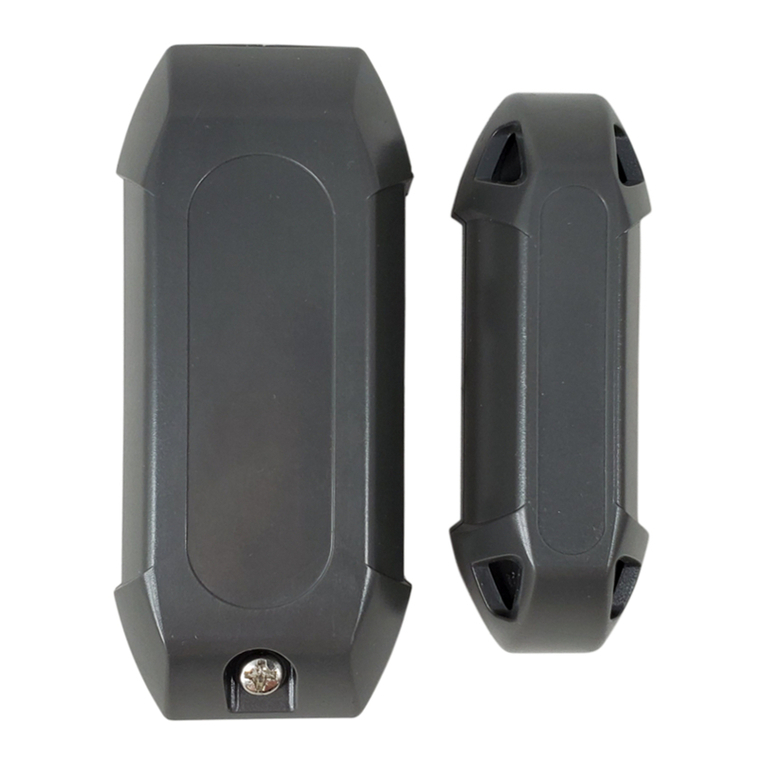
Clare Controls
Clare Controls ClareOne CLR-C1-ODDG installation instructions
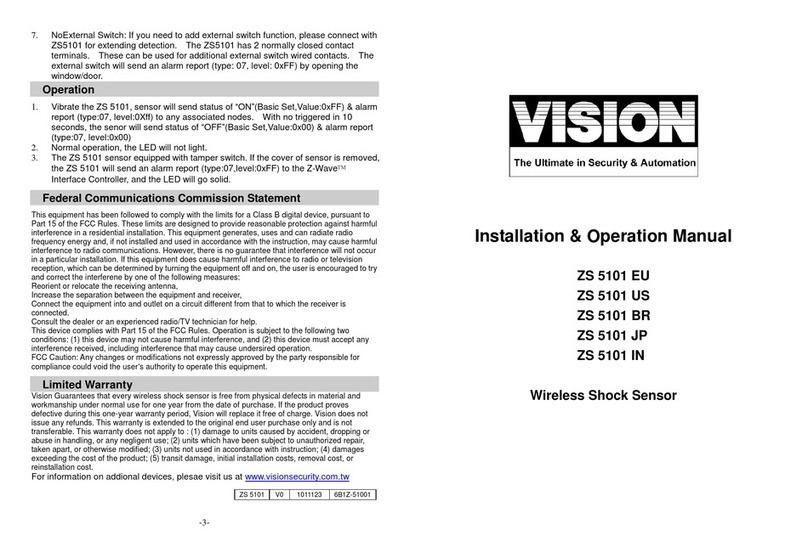
Vision
Vision ZS 5101 EU Installation & operation manual

Smartwares
Smartwares RVS47LA manual
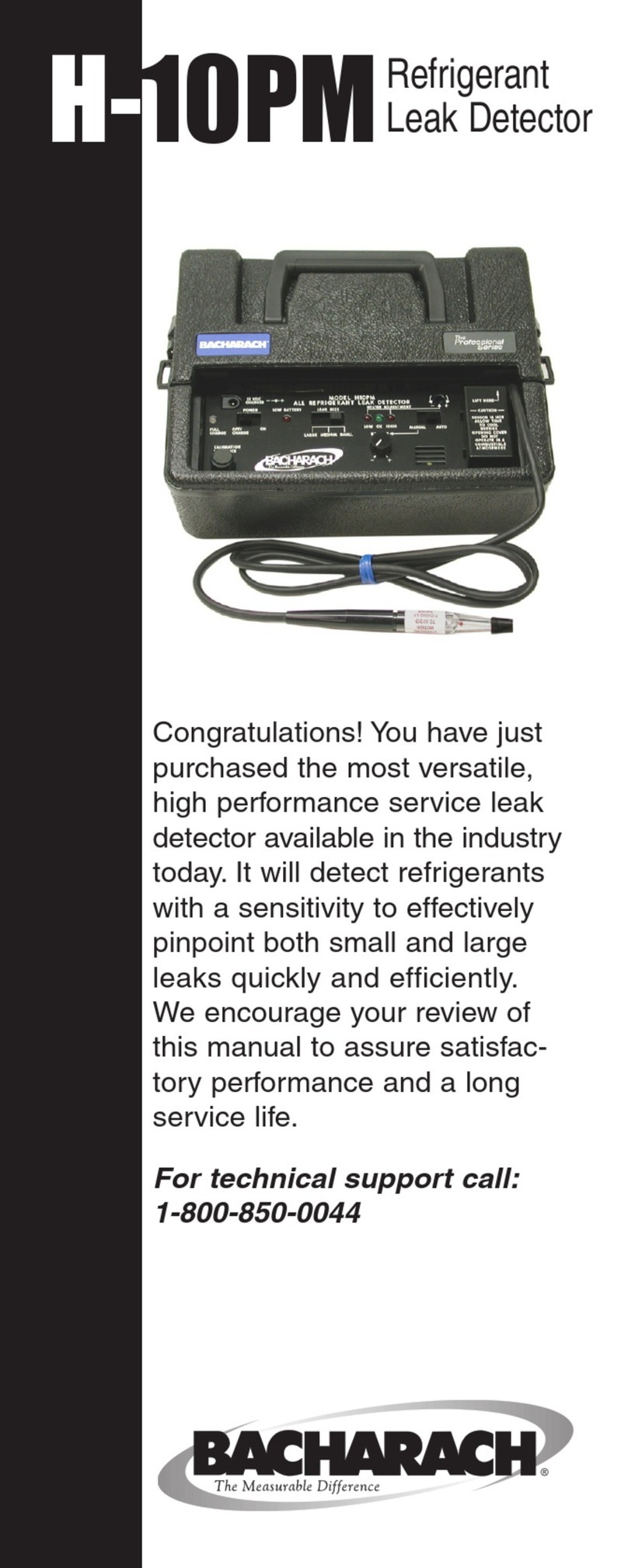
Bacharach
Bacharach H-10PM manual
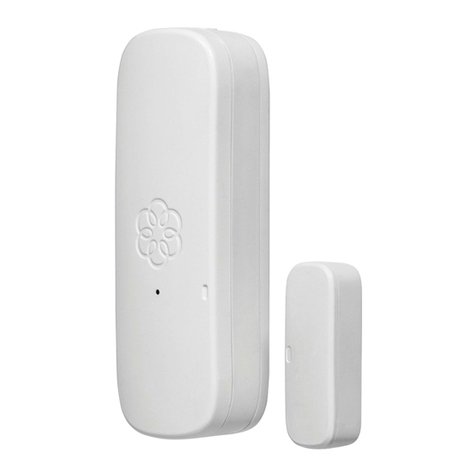
ooma
ooma Smart Security Door and Window Sensor quick start guide
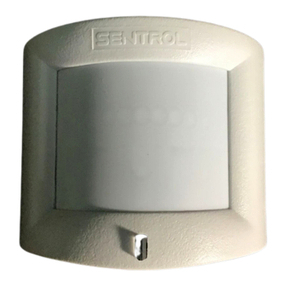
GE
GE PI6000 - Sentrol Motion Detector installation instructions
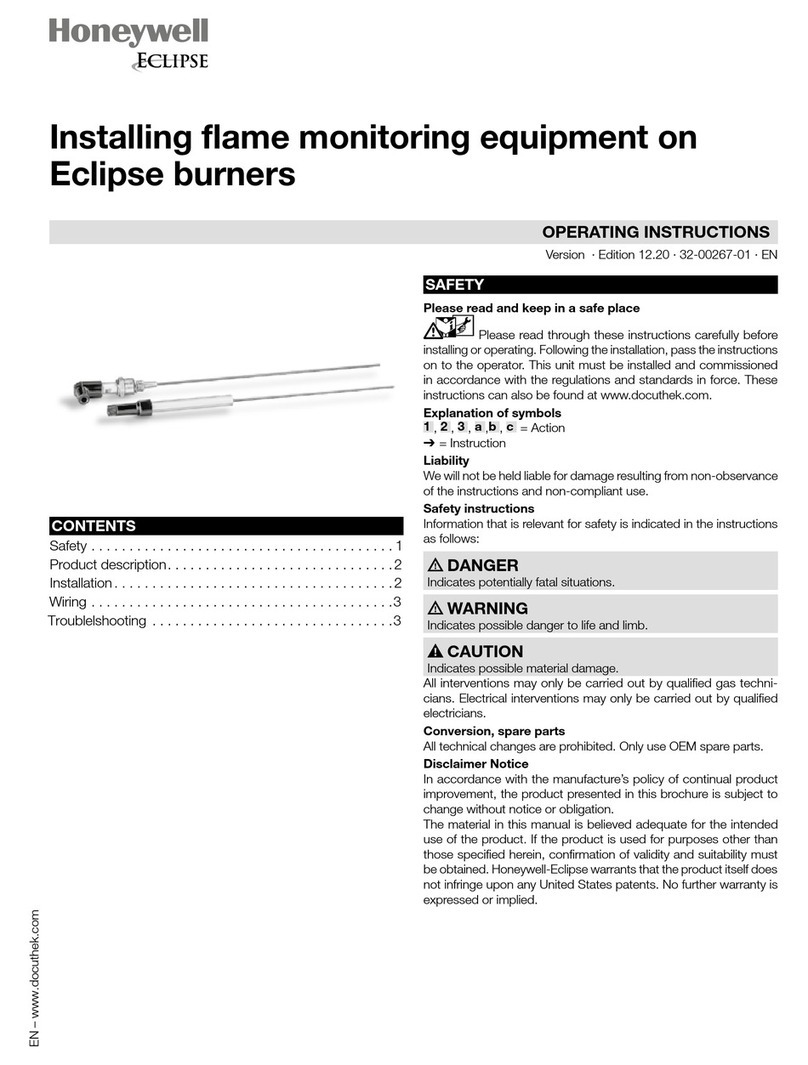
Honeywell
Honeywell Eclipse Installing
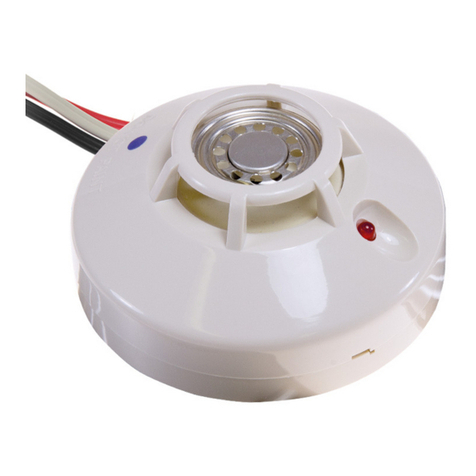
System Sensor
System Sensor 885WP-B Installation and maintenance instructions
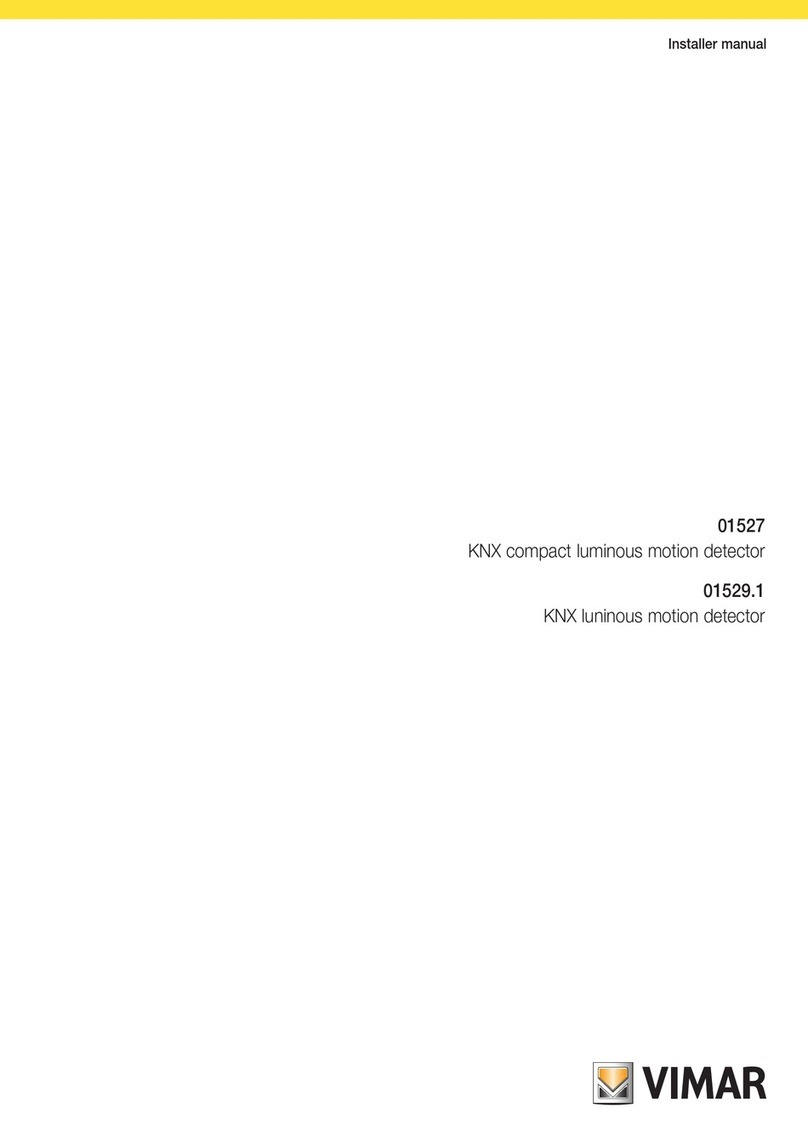
Vimar
Vimar 01527 Installer manual
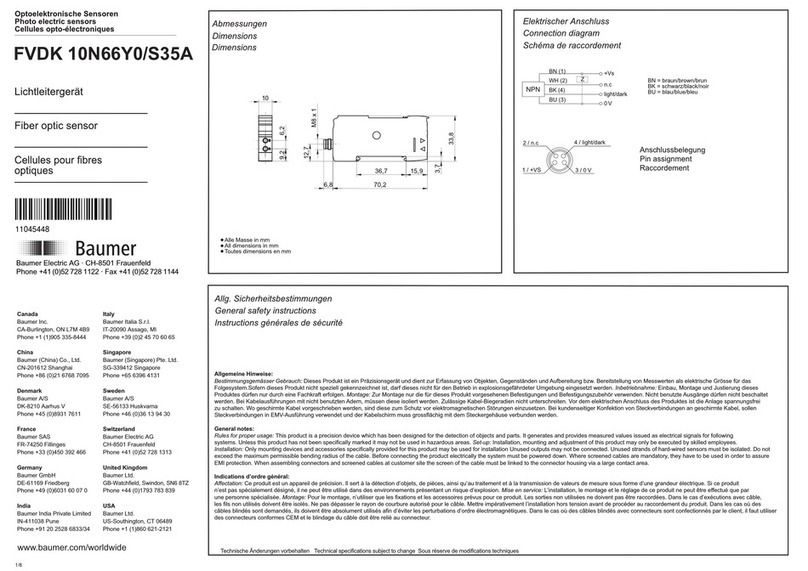
Baumer
Baumer FVDK 10N66Y0/S35A quick start guide
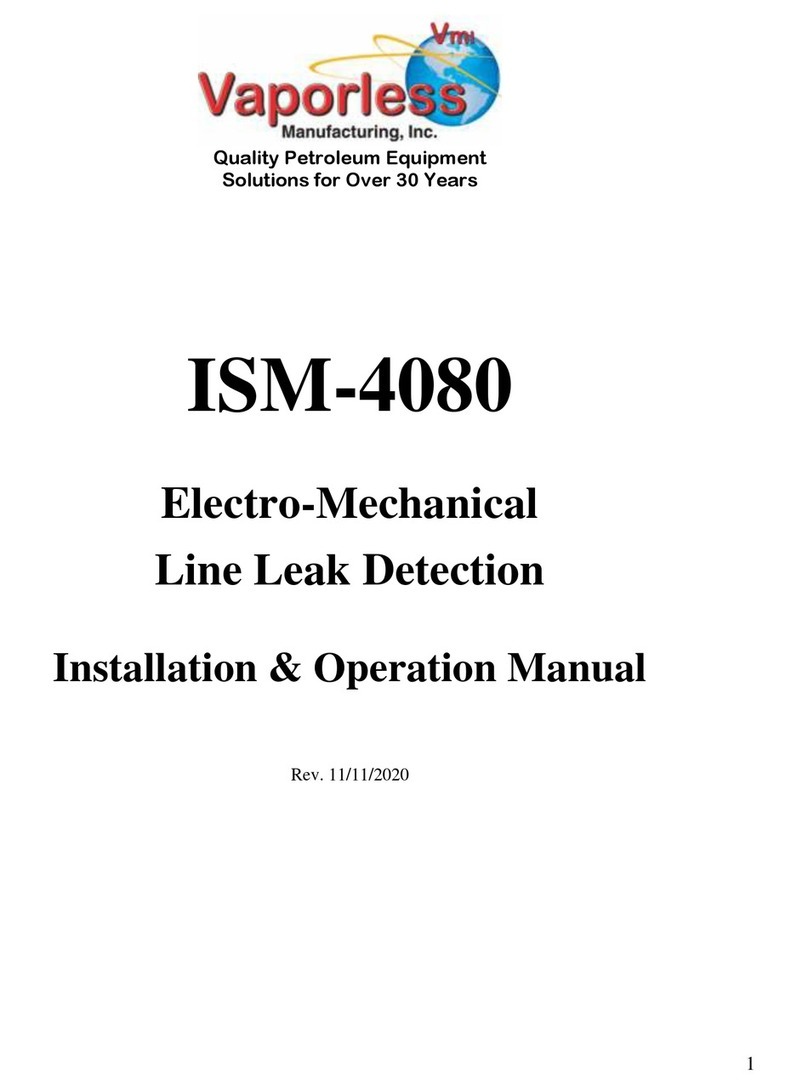
Vaporless
Vaporless ISM-4080 Installation & operation manual

Dräger
Dräger Panorama Nova P Instructions for use

